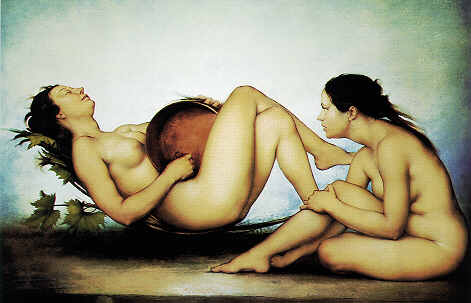

GREED
Now sated, Greed lives as if suspended in the blue air, intoxicated with food and wine, the former obviously portrayed by the empty pan where she avidly dips her hand, the latter by the long vine shoot against which the painter has rested the woman. Her face blissfully obtuse, blind and deaf to everyone and everything around her, only concentrated on her everlasting desire for food. "Greed is time - Donizetti writes in his dialogues without a sequence of events, it is the event that occurs from the mouth to the pylorus". There is anxiety on the face of the other woman. The anxiety to eat in her turn, but also the anxiety of our time, which often finds its tranquilliser in food and, at the same time, the cause for new anxiety, in a vicious circle which obscures the mind and weighs down the body. The allegoric portrayal of Greed is very modern. Here, in final analysis, the sin of greed is shown in the two women, as well as one of its possible psychological causes, so conflicting and contradictory in the relationship with food and body as to alternate bulimia occasionally with its excessive opposite, anorexia.
Greed, Avarice, Lust, three deadly sins which have sprung up from the same root of excessive love for worldly goods. Dante places them in the final frames of Purgatory where the seven deadly sins are cancelled out by a punishment contrary to the nature of their evil. So gluttons cannot help consuming themselves and dying of hunger before food and drink (people who "In fame e in sete qui si rifà santa", in hunger and in thirst are again made saints).